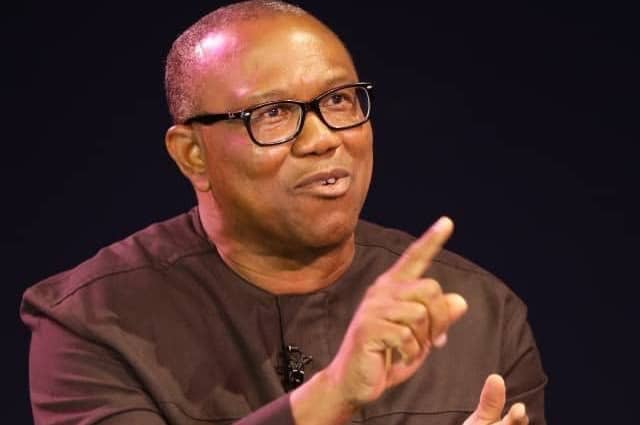Peter Obi, Labour Party (LP) presidential candidate in the 2023 elections, sparked a debate with recent claims of poverty rates in Nigeria and China.
Obi also compared Nigeria with Indonesia and Vietnam while speaking on “Politics and change in Nigeria” at Johns Hopkins University, United States, on April 25.
The invitation was at the behest of Peter Lewis, the professor who authored “Growing Apart: Comparing Indonesia and Nigeria”.
The LP presidential candidate made several claims to emphasise how competent leadership helps nations achieve sustainable growth and development.
Obi shared some of the comments he made via X.
Since then, the post has gathered over 1.1 million views, 19k likes, 6.3k reposts, 1.3k comments, and 492 bookmarks.
CableCheck verified the authenticity of Obi’s statements, and this is what we found.
CLAIM 1: CHINA, INDONESIA, VIETNAM, AND NIGERIA WERE RANKED MEDIUM CATEGORY HDI IN 1990
Verdict: Partly correct
A human development index (HDI) is a composite index that measures a country’s average achievements in health, education, and living standards. The indicators range from 0 as a minimum to 1 as a maximum. Any value less than 0.550 indicates low human development; countries with HDI values between 0.550 and 0.699 have medium human development, those between 0.700 and 0.799 have high human development, and those with 0.800 or greater have very high human development.
Obi said China, Indonesia, Vietnam, and Nigeria “were all classified under the medium category of the HDI measurement” in 1990.
“35 years later, 3 of these nations have moved up to the High category of HDI while Nigeria has fallen into the low category,” he added.
According to a United Nations Development Programme (UNDP) chart, China had an HDI value of 0.482, ranking it in the low category. Vietnam had a value of 0.492, also ranking low. With 0.526 points, Indonesia was the only country that ranked medium. Nigeria’s HDI rank was not listed for the year 1991. The earliest year on the UNDP chart was 2003, when Nigeria had 0.499 points. This placed the sub-Saharan country in the low category. A separate research paper said Nigeria’s HDI value in 1990 was 0.438. This still places it in the low category.
The latest UNDP rankings, published last year, show that China now has a value of 0.788; Indonesia has 0.713; and Vietnam has 0.726, correctly placing them in the high development category as Obi claimed. Nigeria, however, was ranked in the medium category with 0.548 points.
CLAIM 2: CONTRASTING GDPS OF NIGERIA, CHINA, INDONESIA, AND VIETNAM BETWEEN 1990 AND 2005
Verdict: Correct
Obi also examined the gross domestic product (GDP) per capita of all four countries to buttress his point.
“Within the same period of 35 years, from 1990 to 2025, the GDP Per Capita of these comparable nations have all improved,” he said.
“As of 1990, while Nigeria had a GDP per capita of $556, China had $317, Indonesia had $578, and Vietnam had only $99. Nigeria, obviously, had higher GDP per capita than China, while Vietnam had less than one-fifth of Nigeria’s per capita.
“Today, Nigeria’s per capita is about one-fifth of Indonesia’s ($5000) and Vietnam’s ($4400) GDP per capita and below one-tenth of China’s ($1300) GDP per capita.”
According to the World Bank, China had a GDP per capita of $317.9 in 1990. Indonesia had $578.4 while Vietnam had $98.8. Nigeria had a GDP per capita of $556.4.
The International Monetary Fund (IMF) showed the current realities of the countries in a 2025 map. The data set China’s GDP per capita at $1,369; Indonesia’s at $5,003; Vietnam’s at $4,081; and Nigeria’s at $806.84.
CLAIM 3: IN 1990, NIGERIA HAD THE FEWEST POOR PEOPLE AMONG ALL THESE COUNTRIES, BUT TODAY, IT HAS MORE POOR PEOPLE THAN ALL THE OTHER COUNTRIES COMBINED.
Verdict: Largely incorrect
Obi’s final claim was on poverty statistics among the four nations.
He said: “In the area of poverty, Nigeria with about 50 million poor people, had the least number of people in poverty in 1990 than any of the three countries.
“While China had about 750 million people living in poverty, Indonesia and Vietnam had 85 million and 60 million poor people, respectively. China alone had about 15 times the number of poor people than Nigeria.
“Today, however, Nigeria has more poor people than these three countries combined.”
There is no single, universal poverty line; instead, multiple standards exist at both international and national levels. Different organisations and countries use different poverty lines, tailored to their specific contexts, goals, and the populations they serve.
Using the 2017 purchasing power parities (PPP) dollars, the World Bank set the international poverty line at $2.15 per person daily.
The World Bank also uses higher lines for different country income groups: $3.65 per day for lower-middle-income countries and $6.85 per day for upper-middle-income countries.
The World Bank views China as an upper-middle-income country, which means the country’s poverty line is $6.85 per person per day.
Citing the World Bank, the World Economic Forum (WEF) said over 750 million people were living below the international poverty line across China in 1990.
China became an upper-middle-income country according to the World Bank’s national income classification in 2010.
In a document released this month, the World Bank pegged the number of poor people in China at 250 million, using the $6.85 benchmark.
In August 1992, then-Indonesian President Suharto said there were 27 million poor people in 1990. Last year, the Indonesian finance ministry said there were 25.22 million poor people in the Asian country. It was the latest figures released by the ministry.
Some organisations present their data sets in percentages.
According to the United Nations (UN), 34.2 percent of Vietnam’s population in 1990 lived below its international poverty line of $1.25 per day. That same year, the country had a population of 65.5 million. This means about 22.4 million people were believed to be poor.
A Vietnamese government report announcing its most recent data last year said the poverty rate was 2.93 percent. A 2024 mid-term population census showed that as of April 1, 2024, Vietnam’s population was 101,112,656 people. This means only 2.9 million people are poor in Vietnam, according to the country’s public information contained in local reports.
Meanwhile, in Nigeria, the UN indicated that 49.1 percent of the population in 1990 lived below the international poverty line of $1.25 per day. Given the country’s population of 97 million at the time, according to the World Bank, a poverty rate of 49.1 percent would translate to around 47.6 million people.
A 2024 World Bank report pegged the number of poor Nigerians at 129 million, using the national poverty line of $2.48 per person per day, which is slightly higher than the international extreme poverty line of $2.15 — all 2017 PPP.
Using these varying global benchmarks, China’s population of people living in poverty exceeds the combination of the other three countries. This is largely due to its position as the second most populous country in the world, with 1.4 billion people.
Therefore, while China, Vietnam, and Indonesia have lifted millions of people out of poverty, it is not entirely accurate to say Nigeria now has more people living in poverty than these countries combined.





